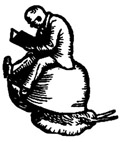This is the immortal flower. A geometry of yellow. Nobody in the foreground or the background. Instead, positioned, there she is. Straddling the calyx: a blue woman holding two babies in her arms. They are wrapped with a jute blanket embroidered with little white stars. It is August 9th, 1947. “I am traveling,” my mother says, “in the wrong direction.” East then South then East again.
Question 1:
What are the maximum and minimum forms a memory can take?
Here on the kitchen table is a drawing of “the immortal flower” (lotus) my mother drew at the height of her illness, two weeks ago. There are 8000 petals, and in the most enlightened beings this planet has hosted, perhaps only four of these petals were opened, my mother informs me. The lotus and the petals constitute: the crown chakra. “What would it be to live a life in which even one petal was unfurled?”—my mother asks.
On the seventieth anniversary of Partition, this is a memory of Partition, from my mother, who was eight years old in the summer of 1947:
“No, we weren't in Lahore. We were in Lyallpur, staying with my uncle there. That was in Pakistan. We left all separately for Meerut, where my great-grandfather had a large house. That's in U.P. When we got to Meerut, there was still a great deal of animosity between the two populations. Day after day, girl after girl was tied to a tree, and after they had abused her, they beheaded her. We saw these things and they were reported in the newspaper also.
In Meerut, my mother had heard that there was a ghost, a ghost who dressed in white, like a holy man, and sold vegetables at night, calling out to the Muslims in their block. The Muslims would switch their lights on, afraid. It was such a dangerous time; my mother, one night, dressed as a sadhu, went for a walk past that block. She had to go to the night market to buy okra, and she wanted to be safe. As she returned to her father-in-law's house, she walked past the block and all the lights went on, and she could hear mothers calling to their children to stay close. The ghost has come, the ghost has come. But then, as she came into the garden of her own home, still dressed in cream-colored cloth, Nanak Chand, my great-grandfather, took out a gun and aimed at her. My uncle and my father said, Put the gun down, baba. At that time, many people acquired a gun, to protect their homes during the time of civil war. “If you kill a holy man...” Nobody knew it was Biji, my mother. Nanak Chand, who was typically a gentle, very quiet man, named for Guru Nanak himself, insisted that it was time to shoot. For some reason, he didn't, and my mother took off her turban and shawl, and then they saw it was her. It was a dreadful time. My uncle was saved by his Muslim friend, who said: “Sharma-ji, take these Muslim clothes. When the Muslims start killing Hindus, put them on. When the Hindus start killing Muslims, take them off.” Chacha-ji got on a train and when he woke up, Muslims had boarded. When he disembarked, there were dead bodies all over the platform, bodies upon bodies. It was only by luck which train he boarded and luck again when he fell asleep. And then, when Pitaji arrived, my father, he didn't speak, he couldn't speak. His clothes were covered in dirt and blood. He drank four liters of water, one after another, then went into the darkest room of the house, weeping and screaming for a long time.”
They had to put him in chains.
Questions I cannot ask my mother:
What does resilience look like in the context of forced migration?
What does resilience look like in the second or third generations that follow an experience of brutal social conflict?
What does resilience look like as you grow older?
What does resilience look like when you did not recover, entirely, in the way that we understand recovery, integration and healing in the West?
Question 2:
Describe a morning you woke without fear.
Today, my mother is telling stories of Partition, which are stories of dismemberment, arrival, the loss of belongings, home, trauma and reactive attachments around which—entire families, and the trajectory of those families, formed.
So far away, we are trying to paint and write in the kitchen, as if painting and writing are antidotes to the ways in which we have lived as a family.
We are trying to drink only half a cup of coffee before throwing it into the trash at the park.
Let me try to take a photograph of my mother's painting/drawing of the immortal flower with my webcam.
No, this is paper which only transmits but cannot receive the images I want to tell.
The immortal flower is gleaming.
The immortal flower orients to the sound of your breathing as you read this page.
The immortal flower is the hard yellow of a beak.
The immortal flower is the soft green of June in England or March in Switzerland or December in Dubai.

